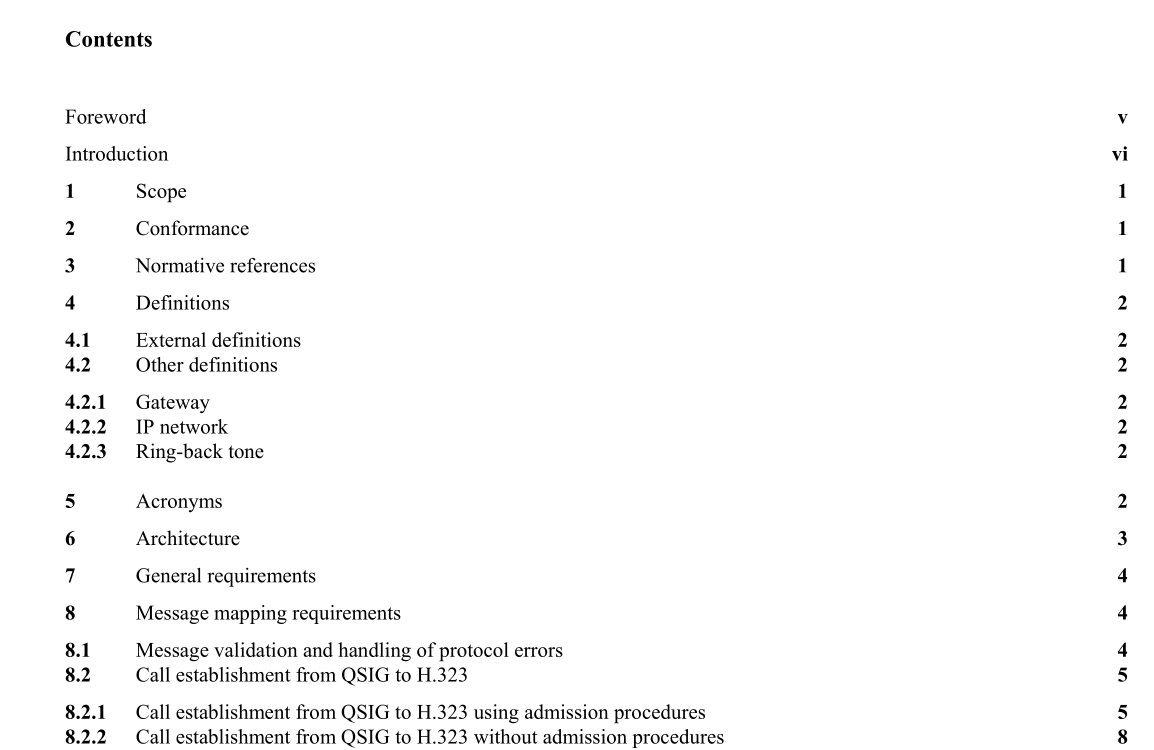ISO IEC 23289 pdf download

ISO IEC 23289 pdf download.Information technology — Telecommunications and information exchange between systems — Corporate telecommunication networks
1 Scope
This International Standard specifies signalling interworking between “QSIG” and “H.323” in support of basic services within a corporate telecommunication network (CN). “QSIG” is a signalling protocol that operates at the Q reference point between Private Integrated services Network eXchange (PINX) within a Private Integrated Services Network (PISN). The Q reference point is defined in ISO/IEC 11579-1. A PISN provides circuit-switched basic services and supplementary services to its users. QSIG is specified in other International Standards, in particular ISO/IEC 11572 (call control in support of basic services). “H.323” is a set of signalling protocols for the support of voice or multimedia communication within a packet network, in particular a packet network that uses the Internet Protocol (IP) as its network layer protocol (IP network). H.323 signalling protocols operate between endpoints in an IP network, either indirectly via one or more gatekeepers, or directly. An endpoint can be a terminal or a gateway to another network. H.323 is an “umbrella” recommendation referring to various ITU-T recommendations, in particular recommendations H.225.0 and H.245 (basic communication capabilities). This International Standard specifies signalling interworking for basic services that provide a bidirectional transfer capability for speech, DTMF, facsimile and modem media between a PISN employing QSIG and a private IP network employing H.323. This International Standard specifies requirements for establishing user information (audio) connections between the PISN and the IP network, but protocols for transmitting audio in the IP network and for signalling in order to establish and close down audio transmission in the IP network are outside the scope of this International Standard. Supplementary services are outside the scope of this International Standard.Interworking between QSIG and H.323 permits a call originating at a user of a PISN to terminate at a user of a private IP network, or a call originating at a user of a private IP network to terminate at a user of a PISN. Interworking between a PISN employing QSIG and a public IP network employing H.323 is outside the scope of this International Standard. However, the functionality specified in this International Standard is in principle applicable to such a scenario when deployed in conjunction with other relevant functionality (e.g., number translation, security functions, etc.). Although two such gateways can operate as peers on either side of an IP network (whereby the IP network provides interconnection between two PISNs), special support for this situation (e.g., tunnelling of QSIG information through the IP network) is outside the scope of this International Standard. Although two such gateways can operate as peers on either side of a PISN (whereby the PISN provides interconnection between two IP networks), special support for this situation (e.g., tunnelling of H.323 information through the PISN) is outside the scope of this International Standard. This International Standard is applicable to any interworking unit that can act as a gateway between a PISN employing QSIG and a private IP network employing H.323.
6 Architecture
This International Standard specifies signalling protocol interworking aspects of a gateway between a PISN employing QSIG signalling and an IP network employing H.323 signalling. The gateway appears as a PINX to other PINXs in the PISN. The gateway appears as an H.323 endpoint to other H.323 entities in the IP network, these being: • other endpoints (terminals, gateways or multipoint control units) that originate calls via the gateway to the PISN and terminate calls via the gateway from the PISN; • gatekeepers, including the gatekeeper with which the gateway registers and other gatekeepers involved in call routing. This environment is illustrated in figure 1.In addition to the signalling interworking functionality specified in this International Standard, it is assumed that the gateway also includes the following functionality: • one or more physical interfaces on the PISN side supporting one or more inter-PINX links, each link providing one or more constant bit rate channels for media information and a reliable layer 2 connection for transporting QSIG signalling messages; and • one or more physical interfaces on the IP network side supporting, through layer 1 and layer 2 protocols, IP as the network layer protocol and UDP and TCP as transport layer protocols, these being used for the transport of media information and H.323 signalling protocols; • a means of transferring media information in each direction between the PISN and the IP network, including, as a minimum, packetization of media information sent to the IP network and de-packetization of media information received from the IP network.









